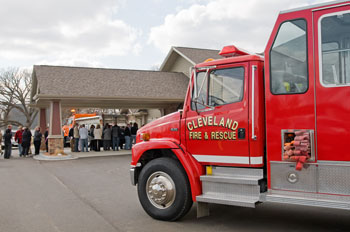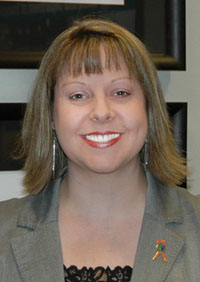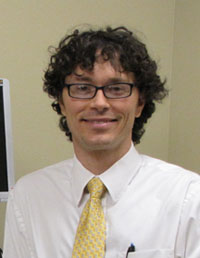 |
|

|
 |
TABLE of CONTENTS
 |
Flooding causes road closures in south-central Minnesota |

Several highways in south-central Minnesota and the southern tip of the Twin Cities Metro area have already closed due to the spring floods of 2011, including this segment of Hwy 22 near Kasota that collapsed March 23.
There are currently closures on five highways in Minnesota:
- Hwy 19 between Hwy 169 and Henderson
- Hwy 22 from Mankato to St. Peter
- Hwy 41 between Carver and Chaska
- Hwy 93 between Le Seur and Henderson
- Hwy 101 in Shakopee
For more information on the spring floods of 2011, visit www.dot.state.mn.us/flood/. Photo courtesy of District 7
|
|
 |
|

|
 |
TABLE of CONTENTS
 |
Co-workers mourn death of District 7ís Mike Struck |

Mike Struck, District 7/Mankato Maintenance, died March 22. Photo courtesy of District 7 |
Mike Struck, District 7/Mankato Maintenance, died March 22 when the backhoe he was using to clear debris along Hwy 169 between Mankato and St. Peter was pulled into the flood waters of Seven Mile Creek, which feeds into the Minnesota River. Struck, 39, worked for the department for nine years.
“The entire Mn/DOT community tragically lost one of our own with the passing of Mike Struck,” said Commissioner Tom Sorel. “Our hearts and prayers go out to his wife Amber and two young children, Kaylee and Gavin, as well as his parents and many friends and co-workers.”
Hundreds gathered at the Church of St. Peter, in St. Peter, Minn., for Struck’s funeral service March 28, including Gov. Mark Dayton, Commissioner Sorel and dozens of Mn/DOT employees.
“The support shown by the Governor’s Office, Commissioner’s Office and all other Mn/DOT districts and offices is greatly appreciated by all District 7 employees,” said Jim Swanson, D7 District Engineer.
Struck’s sudden death is being felt by many people, especially those who worked with him and knew him best.
“Mike considered Mn/DOT his dream job. He enjoyed operating the equipment, and could run almost anything," said Tony DeSantiago, Struck’s supervisor at the District 7/Mankato Truck Station. “With that attitude, he was always fun to work with.”

A line of family and friends stretches outside of the North Mankato Mortuary on March 27 at the visitation for Mike Struck, District 7/Mankato Maintenance. A Mn/DOT snowplow and Cleveland city fire truck were staged in the parking lot. Struck was a volunteer firefighter in his hometown of Cleveland, Minn. Photo by David Gonzalez
|
“Windy,” as his co-workers called him, usually got the morning conversation started and carried it through the day, according to DeSantiago.
“The loss of Mike’s presence is being felt by everyone in District 7,” DeSantiago said. “Mike simply cannot be replaced.”
Struck is the 33rd Mn/DOT employee who has died on the job since 1960.
“Mike was a dedicated employee who did his job well and accepted the risks it sometimes entailed,” Sorel said. “His passing is a heartbreaking reminder of the dangers our men and women deal with in pursuit of keeping Minnesota’s roads clear and safe for the driving public.”
A memorial fund to help educate Struck’s children has been established in his name. Employees interested in contributing can make checks to:
Mike Struck Memorial Fund
c/o Nicollet County Bank
220 South Third Street
St. Peter, MN 56082 |
 |
|

|
 |
TABLE of CONTENTS
 |
Interactive map provides shared view of road conditions, aids in flood response |
|
The Office of Information and Technology Services recently developed a GIS-based map tool that is currently being used to aid in the flood response and recovery in Minnesota. The Emergency Closure Viewer provides a shared view of all road conditions in Minnesota, combining up-to-the-minute closure, restriction and detour information for both state and local roads.
“The viewer tool addresses a common business problem of bringing together road status information from local and state maintained roads to one location,” said Paul Weinberger, OITS. “This is extremely beneficial for the National Guard, Homeland Security, State Patrol, the Red Cross and other agencies that need to respond to situations and deploy equipment and supplies.”
In addition, the viewer provides emergency workers and the public a common view of all road information for travel planning. The interactive map allows users to scan the entire state or select specific counties to view current conditions, while a separate base map feature allows people to alternate between street, topographic and satellite views.
Sixty-one counties experiencing flooding conditions update the map through an editor application developed by OITS, which allows them to enter any event related to roads—closures and incidents. This provides for more immediate reporting of the events, according to Weinberger.
“The transactions, data and service are hosted at Mn/DOT and served back to the counties,” Weinberger said. “The only technology required for the counties is a web browser and web access.”
For each road event, counties also can enter information regarding the extent of damage, reported time of damage and when a road reopens after closure. This information aids in emergency management response and planning, according to Weinberger. The application also will be available to cities in the future.
During this year’s flood season, the Emergency Closure Viewer is available for statewide view, along with Mn/DOT’s 511 system.
For more information on the Emergency Closure Viewer, contact Weinberger at 651-366-4121.
|
 |
|

|
 |
TABLE of CONTENTS
 |
Minnesota GO will shape multimodal transportation system vision for next 50 years |
By Chris Krueger Minnesotans will help determine the state’s transportation system vision for the next 50 years under a process Mn/DOT rolled out last week.
“Minnesota GO is our opportunity to hear from Minnesotans about their expectations for transportation today and for the next generation of Minnesotans,” said Commissioner Tom Sorel. “We are committed to creating a transportation system that will sustain and connect a vital economy, healthy environment and strong communities.”
Minnesota GO will take place through August 2011 and provide Minnesotans with opportunities to get involved through online activities, advisory groups, public workshops and hearings. Mn/DOT also will reach individuals through targeted outreach. A 29-member steering committee representing other public agencies and community organizations will review public comments, advisory group discussions, and quality of life research. The group will then draft and recommend a vision statement and set of objectives for the Mn/DOT commissioner and senior leadership to adopt.
At the end of the process, Mn/DOT will begin updating the statewide multimodal transportation plan and other investments and plans for roads, rails, transit, airports, ports and trails.
“The Minnesota GO process will help Mn/DOT prioritize multiple goals, limited financial resources and an aging infrastructure,” said Mark Nelson, Statewide Multimodal Planning director, whose office is leading the effort. “A clearly defined vision will allow us to more consistently align transportation system investments with the expectations of Minnesotans.”
Nelson said Mn/DOT employees also are invited to participate in the discussion by checking out www.minnesotago.org for ways to get involved. The website is hosted by the Citizen’s League and will be updated regularly with new content, discussion questions, surveys and videotaped interviews on a range of topics.
Mn/DOT’s transportation system responsibilities include:
- Planning, building and maintaining state roads, bridges, and trails for vehicle operators, bicyclists and pedestrians.
- Planning and funding regional airports, railroads, public transit and ports owned and operated by local governments and private companies.
- Providing technical and financial assistance for local roads.
|
|
 |
|

|
 |
TABLE of CONTENTS
 |
Tracy Hatch becomes new chief financial officer |
|
By Lisa Yang

Tracy Hatch has been named the agency’s chief financial officer. Photo by Lisa Yang |
Tracy Hatch has been appointed as chief financial officer. She succeeds Pam Tschida, who served as acting chief financial officer for the past three months.
“Tracy Hatch has demonstrated strong leadership and excellent financial expertise in the past and I am very confident that she will do an exceptional job as our financial spokesperson,” Commissioner Tom Sorel said.
As CFO, Hatch will serve as the agency’s chief financial spokesperson and work with the Legislature, Office of the Legislative Auditor, Department of Finance, and other state and federal agencies with regard to Mn/DOT’s financial activities, budget status and overall financial goals.
Hatch began her Mn/DOT career in March 2009 as budget director for before taking on the role of Operations Division’s business manager. Hatch also spent six years at the Department of Human Services in various budget and financial positions prior to coming to Mn/DOT.
“I’m looking forward to working with and supporting the wonderful staff in the Office of Finance,” Hatch said.
Hatch’s office is located on the fourth floor at Central Office. She can be contacted at 651-366-4811 or tracy.hatch@state.mn.us. |
 |
|

|
 |
TABLE of CONTENTS
 |
New courses help create project management success |
By Bob Filipczak
A second series of project management training courses is now open for registration. Interested employees should contact their training representative to register for any of the following classes:
- Project Leadership, Management and Communications (April 5-7)
- Leading Project Managers (April 20-21)
- Negotiation Skills for Project Managers (April 26-28)
- Risk Management for Project Managers (May 10-12)
The courses are a departure from the way project management training has been offered in past, according to Jean Wallace, Policy Analysis, Research and Innovation Office director. In collaboration with the Office of Technical Support, Project Scope and Cost Management, Wallace is overseeing the program and said the courses this year are different because the program is based on the principles of project management as defined by Project Management Institute and the Project Management Body of Knowledge.
“In the past, the department focused project management training specifically on highway projects,” Wallace said. “These new courses provide a broader, more global picture of project management that can be applied to virtually any project a manager might encounter.”
The broader application was one of the major recommendations of the project management peer review conducted in late 2009.
“If you want to more efficiently manage your scope, schedule and budget, and if you want to manage your risks and resources and the quality of your project, this training will give you the skills and tools you need,” Wallace said. “Plus, it improves your credibility as a project manager and also improves Mn/DOT’s credibility with our customers and stakeholders.”
So what makes a good project manager?
“A good project manager effectively manages cost, schedule and scope, but the soft skills are equally, if not more, important,” Wallace said. “A good project manager also is a good negotiator and communicator that is able to build relationships and establish trust.”
About 90 percent of a project manager’s job is spent in communication, according to PMI.
“The more up-front planning and risk management that goes into a project, the better the overall experience and outcome is, especially for customers,” Wallace said.

Peter Harff, District 7 project manager. Photo by Rebecca Novak |
Peter Harff, District 7 project manager, recently received his certification as a project management professional from PMI and echoes Wallace’s sentiments.
“I think it helps me as a Mn/DOT project manager to organize the flow of work a little better or recognize how to use these processes and work them together to make things happen more efficiently,” Harff said. “It’s really amazing when we do spend the time to plan adequately how much that benefits us in terms of being able to adjust to changing situations and having a good vision of what you want to accomplish when you get to the other side.”
The courses count toward the 35 hours of classroom training required for PMP certification. In addition to the classroom work, there are also 19 different e-learning modules that will be available to employees soon.
Many of the processes established by the project management training will be used in 13 major projects Mn/DOT is currently working on as part of the Major Projects Flagship Initiative, according to Wallace. Part of this effort also will be to develop a scalable project management plan template for all projects.
For more information on the project management training course program, contact Jean Wallace at 651-366-3181. For more information on course registration, contact Norm Plasch, Engineering Services Division, at 651-366-3301.
|
 |
|

|
 |
TABLE of CONTENTS
 |
SWIFT modules progress toward completion |
By Margaret Jones, Office of Financial Management
The Accounts Receivable and the Accounts Payable modules are progressing on schedule toward the July 1 implementation of the StateWide Integrated Financial Tools, the new statewide financial system.
Mary Ann Frasczak, Office of Financial Management, is overseeing the TranSWIFT AR and AP work teams, which are led by Lois Koosmann and Mary Koester, Office of Financial Management. The work teams have been busy analyzing the existing business processes in the Minnesota Accounting and Procurement System, the current statewide financial system; defining the future business processes in SWIFT; and assessing training needs for employees.
“One of the advantages of SWIFT is the ability employees will have to drill down and access more data than they could see in MAPS,” Frasczak said.
Mark Miller, Office of Financial Management, said he believes the SWIFT automated process for budget checking and matching will help streamline business processes within Mn/DOT.
“Business processes may use functions supported by one or more of the SWIFT modules, which may require users to access modules outside of the AR and AP domain to complete end-to-end business processes,” Miller said. “Mn/DOT employees will gain a better understanding of the modules through the training provided by the SWIFT and TranSWIFT training teams.”
| Accounts Receivable |
Accounts Payable |
| Create Bills |
Regular Voucher Entry |
| Adjust Bills |
Voucher Processing |
| Processing Bills |
Voucher Maintenance |
| Create, Adjust, & Process Consolidated Bills |
Payment Processing |
| Create Deposits |
Withholding |
| Apply Payments |
AP Inquiries & Reports |
| Perform AR Account Maintenance |
Integration with Agency Systems |
| Managing Customer Collections |
Journal Voucher Entry |
| Processing Refunds |
Template Vouchers |
| Billing Interface Transactions |
Adjustment Vouchers |
Figure: SWIFT Accounts Receivable and Accounts Payable modules
|
The TranSWIFT Project Team will continue to work closely with the AP and AR work teams to identify the impact of the staged implementation of the SWIFT project to ensure a smooth transition. Closer to the implementation date, the team will provide more information on other areas of the system, as well as the training and support that will be available to future SWIFT users.
For more information about the TranSWIFT project, including project status, schedule and updates, visit ihub/transwift/ or contact Bill Roen, TranSWIFT project director, at 651-366-4076. |
 |
|

|
 |
TABLE of CONTENTS
 |
On the job: Linda Draze cultivates servant leaders |
By Becky Dahlberg

Linda Draze joined Mn/DOT in December 2010 as the agency’s first leadership development project manager. Photo by Becky Dahlberg |
What does it mean to be a servant leader? Linda Draze, leadership development project manager, is always pondering that question at her Arden Hills Training Center office. This is Draze’s second stint with the department; she worked for Mn/DOT from 1990-1994. In December 2010, Draze began her new role as the agency’s first leadership development project manager, where she looks for ways to change employees’ perception of leadership by implementing servant leadership concepts.
What are your current responsibilities?
My role is to support healthy leadership development and help prepare current employees to be effective future leaders.
The goal is to create a robust servant leadership development model that works for everyone at every level, making leadership real for people and giving them the tools to lead. With Mn/DOT’s constantly changing demographics and the Early Retirement Incentive, it is especially relevant since a lot of people are stepping into formal leadership roles that might be new for them.
What is servant leadership?
Servant leadership is grounded in the concept that to be an effective leader you must first be of service to others. It’s not about the position you hold, but about leading wherever you happen to be. It involves behavioral components, and once people adopt the idea personally, they can implement it wherever they’re at. Leadership can be a really fulfilling thing if you embrace it and want to learn about it; it’s one of the most exciting and satisfying things you can experience in your career.
What’s your typical workday like?
There really isn’t a typical workday. Some days are more research-based, where I concentrate on things I’m trying to develop; other days I collaborate with other offices on training events. It’s a nice mix of being able to be with a bunch of other people working on a common goal, while also having reflective time to perform research.
What challenges do you face in your job?
The biggest challenge is knowing that even though Mn/DOT is one agency, there are still multiple cultures within it. All aspects should be supported, and there is no one right answer, model or philosophy for implementing leadership development. You have to learn to be flexible and explore every angle to foster innovation and reach people where they’re at.
What servant leadership tools are currently available?
Relationship building is essential to good leadership practices; you simply can’t do it by yourself. The Workplace of Choice initiative, which seeks to build a professionally stimulating, collaborative work environment, fosters the 10 characteristics of servant leaders:
- Listening
- Empathy
- Healing
- Awareness
- Persuasion
- Conceptualization
- Foresight
- Stewardship
- Commitment to the growth of people
- Building community
Likewise, the Commissioner’s Reading Corner and monthly book discussions are based on a list of books that reflect concepts such as servant leadership. Our office also facilitates a Leadership Foundations class twice a year and a new Peer-to-Supervisor course, which will be piloted this summer.
To learn more about Mn/DOT’s servant leadership philosophy, visit ihub.dot.state.mn.us/servantleadership.
Do you or a co-worker have an interesting job to share with readers? Click here to send us your ideas, and we’ll contact you for more information.
Recent employee profiles:
|
 |
|
| |
|



